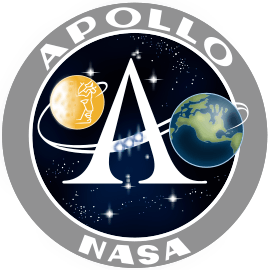Apollo 15
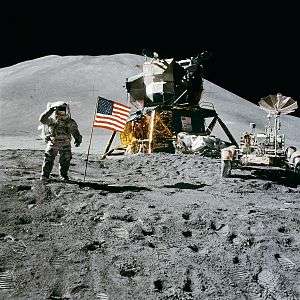 Jim Irwin salutes the United States flag on the Moon, August 1, 1971 | |
| Mission type | Manned lunar landing |
|---|---|
| Operator | NASA[1] |
| COSPAR ID |
|
| SATCAT no. |
|
| Mission duration | 12 days, 7 hours, 11 minutes, 53 seconds |
| Spacecraft properties | |
| Spacecraft |
|
| Manufacturer |
|
| Launch mass | 48,599 kilograms (107,142 lb) |
| Landing mass | 5,321 kilograms (11,731 lb) |
| Crew | |
| Crew size | 3 |
| Members | |
| Callsign |
|
| EVAs |
1 in cislunar space |
| EVA duration |
39 minutes, 7 seconds |
| Start of mission | |
| Launch date | July 26, 1971, 13:34:00.6 UTC |
| Rocket | Saturn V AS-510[2] |
| Launch site | Kennedy LC-39A |
| End of mission | |
| Recovered by | USS Okinawa |
| Landing date | August 7, 1971, 20:45:53 UTC |
| Landing site |
North Pacific Ocean 26°7′N 158°8′W / 26.117°N 158.133°W |
| Orbital parameters | |
| Reference system | Selenocentric |
| Periselene | 101.5 kilometers (54.8 nmi) |
| Aposelene | 120.8 kilometers (65.2 nmi) |
| Inclination | 23 degrees |
| Epoch | July 30, 1971 |
| Lunar orbiter | |
| Spacecraft component | Command/Service Module |
| Orbital insertion | July 29, 1971, 20:05:46 UTC |
| Orbital departure | August 4, 1971, 21:22:45 UTC |
| Orbits | 74 |
| Lunar lander | |
| Spacecraft component | Lunar Module |
| Landing date | July 30, 1971, 22:16:29 UTC |
| Return launch | August 2, 1971, 17:11:23 UTC |
| Landing site | 26°07′56″N 3°38′02″E / 26.1322°N 3.6339°E[3] |
| Sample mass | 77 kilograms (170 lb) |
| Surface EVAs | 4 (including standup) |
| EVA duration |
|
| Lunar rover | |
| Distance covered | 27.9 kilometers (17.3 mi) |
| Docking with LM | |
| Docking date | July 26, 1971, 17:07:49 UTC |
| Undocking date | July 30, 1971, 18:13:16 UTC |
| Docking with LM Ascent Stage | |
| Docking date | August 2, 1971, 19:10:25 UTC |
| Undocking date | August 3, 1971, 01:04:01 UTC |
| Payload | |
| Mass |
|
|
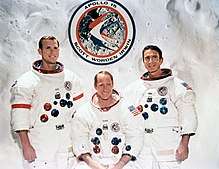 Left to right: Scott, Worden, Irwin | |
Apollo 15 was the ninth manned mission in the United States' Apollo program, the fourth to land on the Moon, and the eighth successful manned mission. It was the first of what were termed "J missions", long stays on the Moon, with a greater focus on science than had been possible on previous missions. It was also the first mission on which the Lunar Roving Vehicle was used. A recording of the launch was included in the Sounds of Earth carried by the Voyager 1 and Voyager 2 space probes.
The mission began on July 26, 1971, and ended on August 7. At the time, NASA called it the most successful manned flight ever achieved.[4]
Commander David Scott and Lunar Module Pilot James Irwin spent three days on the Moon, including 181⁄2 hours outside the spacecraft on lunar extravehicular activity (EVA). The mission landed near Hadley rille, in an area of the Mare Imbrium called Palus Putredinus (Marsh of Decay). The crew explored the area using the first lunar rover, which allowed them to travel much farther from the Lunar Module (LM) than had been possible on missions without the rover. They collected 77 kilograms (170 lb) of lunar surface material. At the same time, Command Module Pilot Alfred Worden orbited the Moon, using a Scientific Instrument Module (SIM) in the Service Module (SM) to study the lunar surface and environment in great detail with a panoramic camera, a gamma-ray spectrometer, a mapping camera, a laser altimeter, a mass spectrometer, and a lunar subsatellite deployed at the end of Apollo 15's stay in lunar orbit (an Apollo program first).
The mission successfully accomplished its objectives, but was marred by negative publicity that accompanied disclosure of the crew carrying unauthorized postage stamps which they had planned to sell after their return. Ironically, this mission was one of very few that had been honored with the issue of a commemorative US stamp, with this first use of a lunar rover happening one decade after the launch of the first manned Mercury mission.
Background
In 1962, NASA contracted for fifteen Saturn V Moon rockets to achieve the Apollo program's goal of a manned landing on the Moon by 1970; at the time no one knew how many missions would be required to achieve this.[5] Since success was obtained with the sixth Saturn V on Apollo 11, nine rockets remained available for a plan of ten total lunar landings. These plans included a heavier, extended version of the Apollo spacecraft to be used in the last five missions (Apollo 16-20). The extensions included a package of lunar orbital experiments carried in the Service Module, and an extended Lunar Module capable of up to 75-hour stays and carrying a Lunar Roving Vehicle to the lunar surface. In the original plan, Apollo 15 was to be the last of the non-extended missions, to land in Censorinus crater. But in anticipation of budget cuts, NASA cancelled the last three landing missions by September 1970. Apollo 15 became the first of three extended missions, known as J missions, and the landing site was moved to Hadley Rille, originally planned for Apollo 19.[6]
Crew and key Mission Control personnel
| Position | Astronaut | |
|---|---|---|
| Commander | David R. Scott[7] Third and last spaceflight | |
| Command Module Pilot | Alfred M. Worden[7] Only spaceflight | |
| Lunar Module Pilot | James B. Irwin[7] Only spaceflight | |
Scott was born in 1932 in San Antonio, Texas, and had graduated from the United States Military Academy in 1954. Serving in the Air Force, Scott had received two advanced degrees from MIT in 1962 before being selected as one of the third group of astronauts the following year. He flew in Gemini 8 in 1966 alongside Neil Armstrong and as Command Module Pilot of Apollo 9 in 1969. Worden was born in 1932 in Jackson, Michigan and like his commander, had attended West Point (class of 1955) and served in the Air Force. Worden earned two master's degrees in engineering from the University of Michigan in 1963. Irwin had been born in 1930 in Pittsburgh, and had attended the United States Naval Academy, graduating in 1951 and serving in the Air Force, receiving a master's degree from Michigan in 1957. Both Worden and Irwin were selected in the fifth group of astronauts (1966), and Apollo 15 would be their only spaceflight.[8]
Backup crew
| Position | Astronaut | |
|---|---|---|
| Commander | Richard F. Gordon Jr.[7] | |
| Command Module Pilot | Vance D. Brand[7] | |
| Lunar Module Pilot | Harrison H. Schmitt[7] | |
Schmitt was the first member of Group 4 to be selected as a prime or backup crew member for an Apollo flight; from Group 4 he was the only astronaut to make it to the Moon, with the last Apollo mission at the end of 1972.
Support crew
All three members of the support crew were scientist-astronauts, selected in 1967, as the prime crew felt they needed more assistance with the science than with the piloting. None of the support crew would fly during the Apollo Program, waiting until the Space Shuttle program for the chance to go into space.[9]
Flight directors
- Gerry Griffin, Gold team
- Milton Windler, Maroon team
- Glynn Lunney, Black team
- Gene Kranz, White team
Capsule Communicators (CAPCOMs)
Mission parameters
- Mass:
- Launch mass: 2,945,816 kg
- Total spacecraft: 46,782 kg
- CSM mass: 30,354 kg, of which CM was 5,840 kg, SM 24,523 kg
- LM mass: 16,428 kg, ascent stage at lunar liftoff 4,951 kg
- Earth orbits: 1.5 before leaving for Moon[11]
- Lunar orbits: 74
Earth parking orbit
LM-CSM docking
- Undocked: July 30, 1971 - 18:13:16 UTC
- Docked: August 2, 1971 - 19:10:25 UTC
EVAs
- Scott - Stand up EVA - LM upper hatch
- Start Stand Up EVA: July 31, 1971, 00:16:49 UTC
- End Stand Up EVA: July 31, 00:49:56 UTC
- Duration: 33 minutes, 07 seconds
- Scott and Irwin - EVA 1
- EVA 1 Start: July 31, 1971, 13:12:17 UTC
- EVA 1 End: July 31, 19:45:59 UTC
- Duration: 6 hours, 32 minutes, 42 seconds
- Scott and Irwin - EVA 2
- EVA 2 Start: August 1, 1971, 11:48:48 UTC
- EVA 2 End: August 1, 19:01:02 UTC
- Duration: 7 hours, 12 minutes, 14 seconds
- Scott and Irwin - EVA 3
- EVA 3 Start: August 2, 1971, 08:52:14 UTC
- EVA 3 End: August 2, 13:42:04 UTC
- Duration: 4 hours, 49 minutes, 50 seconds
- Worden (Irwin - Stand up) - Transearth EVA 4
- EVA 4 Start: August 5, 1971, 15:31:12 UTC
- EVA 4 End: August 5, 16:10:19 UTC
- Duration: 39 minutes, 07 seconds
Planning and training
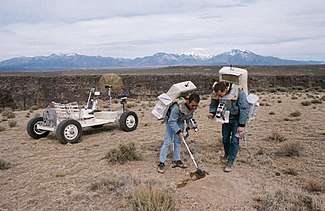
The three Apollo 15 astronauts had served as the backup crew to Apollo 12, and since Apollo 11's backup crew had been designated for Apollo 13 (which did not land on the Moon), they were the first Apollo crew for a successful lunar landing mission to have backed up another such mission.[12] Having had the opportunity to familiarize themselves with the Apollo spacecraft, they could devote more of their training time as prime crew for Apollo 15 to geology and sampling techniques.[ALSJ 1]
The astronauts at NASA who were scientists, such as geologist Harrison Schmitt, pushed though the early Apollo missions for a greater place for science as part of the mission, but often there were higher priorities or astronaut disinterest. Schmitt realized that what was needed was an expert teacher who could fire the astronauts' enthusiasm, and contacted Caltech geologist Lee Silver, whom Schmitt introduced to Apollo 13 mission commander Jim Lovell and Lunar Module Pilot Fred Haise, then in training for their mission. Lovell and Haise were willing to go on a field expedition with Silver, and geology became a significant part of their training. Geologist Farouk El-Baz trained the prime crew's Command Module Pilot, Ken Mattingly to inform his planned observations from lunar orbit. The crew's newly-acquired skills mostly went unused, due to the explosion that damaged the Apollo 13 spacecraft.[lower-alpha 1] Apollo 14's CMP, Stu Roosa, was enthusiastic about geology, but the mission commander, Alan Shepard, less so.[13]
Scott, once assigned as Apollo 15 commander, was determined that his crew bring back the maximum amount of scientific data possible, and met with Silver in April 1970 to begin planning the geological training. The assignment of Schmitt as Apollo 15's backup LMP made him an insider, and allowed him to spark competition between the prime and backup crews. The cancellation of two Apollo missions in September 1970 transformed Apollo 15 into a J mission, with a longer stay on the lunar surface, and the first Lunar Roving Vehicle (LRV). This change was welcomed by Scott,[14] who according to David West Reynolds in his account of the Apollo Program, was "something more than a hotshot pilot. Scott had the spirit of a true explorer," one determined to get the most from the J mission.[15] The additional need for communications, including from experiments in the Command Module and from the rover, required the near-rebuilding of the Honeysuckle Creek Tracking Station in Australia.[16]
Geology field trips took place about once a month, throughout the crew's 20 months of training. At first Silver would take the commanders and LMPs from the prime and backup crews to various geological sites in Arizona and New Mexico as if for a normal field geology lesson, but closer to launch, these trips became more realistic. Crews began to wear mock-ups of the backpacks they would carry, and communicate using walkie-talkies to a CAPCOM in a tent. (During a mission the Capsule Communicators (CAPCOMs), always fellow astronauts, were the only people who normally would speak to the crew.) The CAPCOM was accompanied by a geologist unfamiliar with the area who would rely on the astronauts' descriptions to interpret the findings, and familiarized the crew members with describing landscapes to people who could not see them.[17] Considering himself a serious amateur, Scott came to enjoy field geology.[18]
The decision to land at Hadley came in September 1970. The Site Selection Committees had narrowed the field down to two sites — Hadley Rille, a deep channel on the edge of Mare Imbrium close to the Apennine mountains or the crater Marius, near which were a group of low, possibly volcanic, domes. Although not ultimately his decision, the commander of a mission always held great sway.[19] To David Scott the choice was clear, as Hadley "had more variety. There is a certain intangible quality which drives the spirit of exploration and I felt that Hadley had it. Besides it looked beautiful and usually when things look good they are good."[20] The selection of Hadley was made although NASA lacked high resolution images of the landing site; none had been made as the site was considered too rough to risk one of the earlier Apollo missions.[21] The proximity of the Apennine mountains required a landing approach trajectory of 26 degrees, far steeper than the 15 degrees in earlier Apollo landings.[22]
The expanded mission meant that Worden spent much of his time at North American Rockwell's facilities at Downey, California, where the CSM was being built.[23] Worden undertook a different kind of geology training. Working with El-Baz, he studied maps and photographs of the craters he would pass over while orbiting alone in the CSM. As El-Baz listened and gave feedback, Worden learned how to describe lunar features in a way that would be useful to the scientists who would listen to his transmissions back on Earth. Worden found El-Baz to be an enjoyable and inspiring teacher. In addition, Worden usually accompanied his crewmates on their geology field trips, though he was often in an airplane overhead, describing features of the landscape as the plane simulated the speed at which the lunar landscape would pass below the CSM.[24]
The demands of the training strained Worden's marriage and also that of Irwin; each sought Scott's advice, fearing that divorce might endanger their places on the mission as not projecting the image NASA wanted for the astronauts. Scott consulted Director of Flight Crew Operations Deke Slayton, their boss, who stated what was important was that the astronauts do their jobs. Although the Irwins overcame their marital difficulties, Worden divorced before the mission.[25]
Mission highlights
Launch and outbound trip
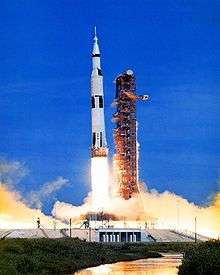
Apollo 15 was launched on July 26, 1971, at 9:34 AM EDT from the Kennedy Space Center at Merritt Island, Florida. The time of launch was at the very start of the two hour, 37 minute launch window, which would allow Apollo 15 to arrive at the Moon with the proper lighting conditions at Hadley Rille; had the mission been scrubbed, it could not have been rescheduled until late August. The astronauts had been wakened five and a quarter hours before launch by Slayton, and after breakfast and suiting up, had been taken to Pad 39A, launch site of all seven attempts at manned lunar landing, and entered the spacecraft about three hours before launch. There were no unplanned delays in the countdown.[ALFJ 1]
At 000:11:36 into the mission, the S-IVB engine shut down, leaving Apollo 15 in its planned parking orbit in Low Earth Orbit. The mission remained there for some 2 hours and 40 minutes, allowing the crew (and Houston, via telemetry) to check the spacecraft's systems. At 002:50.02.6 into the mission, the S-IVB was restarted, for trans-lunar injection (TLI), placing the craft on a path to the Moon.[ALFJ 1][ALFJ 2] Prior to TLI, the craft had completed 1.5 orbits around the Earth.[11]
The Command and Service Module (CSM), and the Lunar Module, remained attached to the nearly-exhausted S-IVB booster. Once trans-lunar injection had been achieved, placing the spacecraft on a trajectory towards the Moon, explosive cords separated the CSM from the booster as Worden operated the CSM's thrusters to push it away. Worden then maneuvered the CSM to dock with the LM (mounted on the end of the S-IVB), and the combined craft was then separated from the S-IVB by explosives. After Apollo 15 separated from the booster, the S-IVB maneuvered away, and would impact the Moon about an hour after the crewed spacecraft entered lunar orbit, though due to an error the impact was 79 nautical miles (146 km) away from the intended target.[ALFJ 3] The booster's impact was detected by the seismometers left on the Moon by Apollo 12 and Apollo 14, providing useful scientific data.[26]
There was a malfunctioning light on the craft's Service Propulsion System (SPS); after considerable troubleshooting, the astronauts did a test burn of the system that also served as a midcourse correction. This occurred about 028:40:00 into the mission. After the mission returned, the malfunction proved to be caused by a tiny bit of wire trapped within the switch.[ALFJ 4]
After purging and renewing the LEM's atmosphere to eliminate any contamination, the astronauts entered the LEM about 34 hours into the mission, needing to check the condition of its equipment and move in items that would be required on the Moon. Much of this work was televised back to Earth, the camera operated by Worden. The crew discovered a broken outer cover on the Range/Range rate tapemeter. This was a concern not only because an important piece of equipment might not work properly, but because bits of the glass cover were floating around Falcon's interior.[ALFJ 5] The tapemeter was supposed to be in a helium atmosphere, but due to the breakage, it was in the LEM's oxygen atmosphere and lower pressure. Testing on the ground verified the tapemeter would still work properly, and the crew removed most of the glass using a vacuum cleaner and adhesive tape.[ALFJ 5][27]
As yet, there had been only minor problems, but at about 61:15:00 mission time (the evening of July 28 in Houston), Scott discovered a leak in the water system while preparing to chlorinate the water supply. The crew could not tell where it was coming from, and the issue had the potential to become serious. The experts in Houston found a solution, which was successfully implemented by the crew. The water was mopped up with towels, which were then put out to dry in the tunnel between the Command Module and Lunar Module—Scott stated it looked like someone's laundry.[ALFJ 6]
At 73:31:14 into the mission, a second midcourse correction, with less than a second of burn, was made. Although there were four opportunities to make midcourse corrections following TLI, only two needed to be used. Apollo 15 approached the Moon on July 29, and the Lunar Orbit Insertion (LOI) burn had to be made using the SPS, on the far side of the Moon, out of radio contact with Earth. If no burn occurred, Apollo 15 would emerge from the lunar shadow and come back in radio contact faster than expected; the continued lack of communication allowed Mission Control to conclude that the burn had taken place. When contact resumed, Scott did not immediately give the particulars of the burn, but spoke admiringly of the beauty of the Moon, causing Alan Shepard, the Apollo 14 commander, who was awaiting a television interview, to grumble, "To hell with that shit, give us details of the burn."[ALFJ 7] The 398.36-second burn took place at 078:31:46.7 into the mission at an altitude of 86.7 nautical miles (160.6 km) above the Moon, and placed Apollo 15 in an elliptical lunar orbit of 170.1 by 57.7 nautical miles (315.0 by 106.9 km).[27]
Lunar orbit and landing
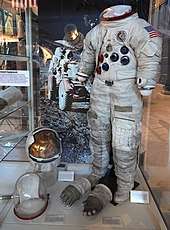
On Apollo 11 and 12, the Lunar Module decoupled from the CSM and descended to a much lower orbit from which the lunar landing attempt commenced; to save fuel in an increasingly heavy lander, beginning with Apollo 14, the SPS in the Service Module made that burn, known as Descent Orbit Insertion (DOI), with the Lunar Module still attached to the CSM. The initial orbit Apollo 15 was in had its apocynthion, or high point, over the landing site at Hadley; a burn at the opposite point in the orbit was performed, with the result that Hadley would now be under the craft's pericynthion, or low point.[ALFJ 8] The DOI burn was performed at 082:39:49.09 and took 24.53 seconds; the result was an orbit with apocynthion of 58.5 nmi and pericynthion of 9.6 nmi.[28] Overnight between July 29 and 30, as the crew rested, it became apparent to Mission Control that mass concentrations in the Moon were making Apollo 15's orbit increasingly elliptical—pericynthion was 7.6 nmi by the time the crew was awakened on July 30. This, and uncertainty as to the exact altitude of the landing site, made it desirable that the orbit be modified, or trimmed. Using the craft's RCS thrusters,[ALFJ 9] this took place at 095:56:44.70, lasting 30.40 seconds, and raised the pericynthion to 8.8 nmi and the apocynthion to 60.2 nmi.[28]
In addition to preparing the Lunar Module for its descent, the crew continued observations of the Moon (including of the landing site at Hadley) and provided television footage of the surface. Undocking was planned for 100:13:56, over the far side of the Moon, but nothing happened when separation was attempted.[ALFJ 10] After analyzing the problem, the crew and Houston decided the probe instrumentation umbilical was likely loose or disconnected; Worden went into the tunnel connecting the Command and Lunar modules and determined this was so, seating it more firmly. With the problem resolved, Falcon separated from Endeavour at 100:39:16.2, about 25 minutes late, at an altitude of 7.4 nmi. Worden in Endeavour executed a SPS burn at 101:38:58.98 to send Endeavour to an orbit of 65.2 x 54.8 nmi in preparation for his scientific work.[29]
Aboard Falcon, Scott and Irwin prepared for Powered Descent Initiation (PDI), the burn that was to place them on the lunar surface, and, after Mission Control gave them permission,[ALSJ 2] they initiated PDI at 104:30:09.4 at an altitude of 5.8 nmi,[29] slightly higher than planned. During the first part of the descent, Falcon was aligned so that the astronauts could not see the lunar surface below them, but after the craft made a maneuver known as "pitchover", they could, and Scott was confronted with a landscape that did not fully resemble what he had seen during simulations of the landing. Part of this was due to an error in the landing path of some 3,000 feet (910 m), of which the CAPCOM, Ed Mitchell informed the crew prior to pitchover; part because the craters Scott had relied on in the simulator were difficult to make out under lunar conditions, and he initially could not see Hadley Rille. He concluded that they were likely to overshoot the planned landing site, and, once he could see the rille, started looking for a relatively smooth landing spot as close as possible to plan.[ALSJ 2][30]
Below about 60 feet (18 m), Scott could see nothing of the surface because of the quantities of lunar dust being displaced by Falcon's exhaust. Falcon had a larger engine bell than previous LEMs, in part to accommodate a heavier load, and the importance of shutting down the engine rather than risk "blowback", the exhaust reflecting off the lunar surface and going back into the engine (possibly causing an explosion) had been impressed on the astronauts by mission planners. Thus, when Irwin called "Contact", indicating that one of the probes on the landing leg extensions had touched the surface, Scott immediately shut off the engine. Scott's speed resulted in what was likely the hardest lunar landing of any of the manned missions, at about 6.8 feet (2.1 m) per second, causing a startled Irwin to yell "Bam!" Scott had landed Falcon on the rim of a small crater he could not see, and the lander settled back at an angle of 6.9 degrees and to the left of 8.6 degrees.[ALSJ 2] Irwin described it in his autobiography as the hardest landing he had ever been in, and he feared that the craft would keep tipping over, forcing an immediate abort.[31] Falcon landed at 104:42:29.3 (22:16:29 GMT on July 30), with approximately 103 seconds of fuel remaining, about 1,800 feet (550 m) from the planned landing site.[29] After Irwin's exclamation, Scott reported, "Okay, Houston. The Falcon is on the Plain at Hadley."[lower-alpha 2][ALSJ 2]
Lunar surface
David Scott, upon setting foot on the Moon.[ALSJ 3]
With Falcon due to remain on the lunar surface for almost three days, Scott deemed it important to maintain the circadian rhythm they were used to, and as they had landed in the late afternoon, Houston time, the two astronauts were to sleep before going onto the surface. But the time schedule allowed him to open the lander's top hatch (usually used for docking) and spend a half hour looking at their surroundings, describing them, and taking photographs. Lee Silver had instilled in him the importance of going to a high place to survey a new field site, and the top hatch of the Falcon served that purpose.[32][ALSJ 2][ALSJ 4] Deke Slayton and other managers had initially been in opposition, due to the oxygen that would be lost, but Scott got his way.[33] During the only stand-up extravehicular activity (stand-up EVA) ever performed through the top hatch on the lunar surface, Scott was able to make plans for the following day's EVA.[34] He offered Irwin a chance to look out as well, but this would have required rearranging the umbilicals connecting Irwin to the Falcon's life support system, and he declined.[35] After repressurizing the spacecraft, Scott and Irwin removed their spacesuits for sleep, becoming the first astronauts to doff their suits while on the Moon.[36]
Throughout the sleep period, Mission Control, in Houston, monitored a slow but steady oxygen leak. Scott and Irwin eventually were awakened an hour early, and the source of the leak was found to be an open valve on the urine transfer device. In post-mission debriefing, Scott recommended that future crews be woken at once if Houston detected a leak. After the problem was solved, the crew began preparation for the first Moon walk.[ALSJ 5]
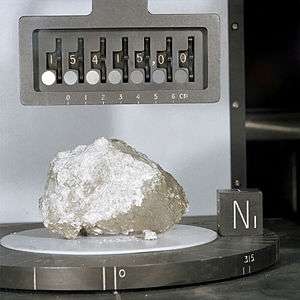
After donning their suits and depressurizing the cabin,[ALSJ 6] Scott and Irwin began their first full EVA, becoming the seventh and eighth humans, respectively, to walk on the Moon.[37] They attempted to deploy the lunar rover, stored folded up on the outside of Falcon's descent stage, but this proved troublesome due to the slant of the lander. The experts in Houston suggested lifting the front end of the rover as the astronauts pulled it out, and this worked.[38] One of the batteries gave a zero voltage reading, but this proved to be an instrumentation problem. A greater concern was that the front wheel steering would not work, but the rear wheel steering was sufficient to maneuver the vehicle.[39] The rover carried a television camera, controlled remotely from Houston by NASA's Ed Fendell. The resolution was not high compared to the still photographs that would be taken, but the camera allowed the geologists on Earth to indirectly participate in Scott and Irwin's activities.[40]
The rille was not visible from the landing site, but as Scott and Irwin drove over the rolling terrain, it came into view,[41] They were able to see Elbow Crater, and they began to drive in that direction.[ALSJ 7] Reaching Elbow, a known location, allowed Mission Control to backtrack and get closer to pinpointing the location of the lander. The astronauts took samples there,[42] and then drove to another crater on the flank of Mt. Hadley Delta, where they took more samples. After concluding this stop, they returned to the lander to drop off their samples and prepare to set up the Apollo Lunar Surface Experiments Package (ALSEP), the scientific instruments that would remain when they left.[43] Scott had difficulty drilling the holes required for the heat flow experiment, and the work was not completed when they had to return to the lander.[44] The first EVA lasted about 61⁄2 hours.[45][ALSJ 8]
The target of the second EVA, the next day, was the edge of Mount Hadley Delta, where the pair sampled boulders and craters along the Apennine Front. During this moonwalk, the astronauts recovered what came to be one of the more famous lunar samples collected on the Moon during Apollo, sample #15415, more commonly known as the "Genesis Rock." Once back at the landing site, Scott continued to try to drill holes for an experiment at the ALSEP site, with which he had struggled the day before. After conducting soil-mechanics experiments and erecting a U.S. flag, Scott and Irwin returned to the LM. EVA 2 lasted 7 hours and 12 minutes.[45][ALSJ 8]
During EVA 3, the third and final moonwalk of the mission, the crew again ventured to the edge of Hadley Rille, this time to the northwest of the immediate landing site. After returning to the LM's location, Scott performed an experiment in view of the television camera, using a feather and hammer to demonstrate Galileo's theory that all objects in a given gravity field fall at the same rate, regardless of mass (in the absence of aerodynamic drag). He dropped the hammer and feather at the same time; because of the negligible lunar atmosphere, there was no drag on the feather, which hit the ground at the same time as the hammer.
Scott then drove the rover to a position away from the LM, where the television camera could be used to observe the lunar liftoff. Before the mission, the crew had contacted Belgian sculptor Paul Van Hoeydonck to create a small aluminum statuette called Fallen Astronaut to commemorate those astronauts and cosmonauts who lost their lives in the pursuit of space exploration. Scott left the sculpture by the rover, along with a plaque bearing the names of 14 known American astronauts and Soviet cosmonauts deceased by that time.[46][47] The memorial was left while the television camera was turned off; only Irwin knew what Scott was doing at the time. Scott told mission control he was doing some cleanup activities around the rover. During EVA 3, Scott wore a Bulova chronograph back-up watch in replacement of the official NASA Omega Speedmaster Professional chronograph, whose crystal popped off during EVA 2.[48]
The EVA lasted 4 hours and 50 minutes.[45][ALSJ 8] In total, the two astronauts spent 181⁄2 hours outside the LM and collected approximately 77 kg (170 lb) of lunar samples.[ALSJ 8]
Return to Earth
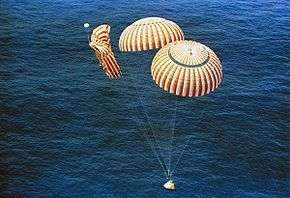
After lifting off from the lunar surface 2 days and 18 hours after landing, the LM ascent stage rendezvoused and re-docked with the CSM with Worden aboard in orbit. After transferring samples and other items from the LM to the CSM, the LM was sealed off, jettisoned, and intentionally crashed into the lunar surface. After completing more observations of the Moon from orbit and releasing the subsatellite, the three-person crew departed lunar orbit with another burn of the SPS engine.[49]
The next day, on the return trip to Earth, Worden performed a spacewalk in deep space, the first of its kind, to retrieve exposed film from the SIM bay. Later on in the day, the crew set a record for the longest Apollo flight to that point.[50]
On approach to Earth the next day, August 7, the Service Module was jettisoned, and the Command Module (CM) reentered the Earth's atmosphere. Although one of the three parachutes on the CM failed to deploy properly, only two were required for a safe landing (one extra for redundancy). Upon landing in the North Pacific Ocean, the crew were recovered and taken aboard the recovery ship, USS Okinawa after a mission lasting 12 days, 7 hours, 11 minutes, and 53 seconds.[49][45]
Hardware
Spacecraft
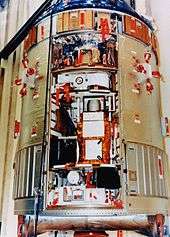

Apollo 15 used Command/Service Module CSM-112, which was given the call sign Endeavour, named after HMS Endeavour and Lunar Module LM-10, call sign Falcon, named after the United States Air Force Academy mascot. Scott explained the choice of the name Endeavour on the grounds that its captain, James Cook had commanded the first purely scientific sea voyage, and Apollo 15 was the first lunar landing mission on which there was a heavy emphasis on science.[51] If Apollo 15 had flown as an H mission, it would have been with CSM-111 and LM-9. That CSM was used by the Apollo–Soyuz Test Project in 1975,[ALSJ 9] but the Lunar Module went unused and is now on display at the Kennedy Space Center Visitor Complex.[52]
Technicians at the Kennedy Space Center had many problems with the SIM bay in the Service Module. It was the first time it had flown and experienced problems from the start. Problems came from the fact the instruments were designed to operate in zero gravity, but had to be tested in the 1 g on the surface of the Earth. As such, things like the 7.5 m booms for the mass and gamma ray spectrometers could only be tested using railings that tried to mimic the space environment, and so they never worked particularly well. When the technicians tried to integrate the entire bay into the rest of the spacecraft, data streams would not synchronize, and lead investigators of the instruments would want to make last minute checks and changes. When it came time to test the operation of the gamma-ray spectrometer, it was necessary to stop every engine within 10 miles (16 km) of the test site.
On the Lunar Module, the fuel and oxidizer tanks were enlarged on both the descent and ascent stages and the engine bell on the descent stage was extended. Batteries and solar cells were added for increased electrical power. In all this increased the weight of the Lunar Module to 36,000 pounds (16,000 kilograms), 4,000 pounds (1,800 kg) heavier than previous models.
Endeavour is currently on display at the National Museum of the United States Air Force at Wright-Patterson Air Force Base in Dayton, Ohio.
Lunar Rover
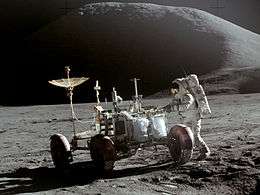
A vehicle that could operate on the surface of the Moon had been considered by NASA since the early 1960s. An early version was called MOLAB, which had a closed cabin and would have massed about 6,000 pounds (2,700 kg); some scaled-down prototypes were tested in Arizona. As it became clear NASA would not soon establish a lunar base, such a large vehicle seemed unnecessary. Still, a rover would enhance the J missions, which were to concentrate on science, though its mass was limited to about 500 pounds (230 kg) and it was not then clear that so light a vehicle could be useful. NASA did not decide to proceed with a rover until May 1969, as Apollo 10, the dress rehearsal for the Moon landing, made its way home from lunar orbit. Boeing got the contract for three rovers on a cost plus basis; overruns (especially in the navigation system) meant that the three vehicles eventually cost a total of $40 million.[53]
The Lunar Roving Vehicle could be folded into a space 5 ft by 20 in (1.5 m by 0.5 m). Unloaded, it weighed 460 lb (209 kg) and when carrying two astronauts and their equipment, 1500 lb (700 kg). Each wheel was independently driven by a ¼ horsepower (200 W) electric motor. Although it could be driven by either astronaut, the Commander always drove. Travelling at speeds up to 6 to 8 mph (10 to 12 km/h), it meant that for the first time the astronauts could travel far afield from their lander and still have enough time to do some scientific experiments.[54] During pre-launch testing, the LRV was given additional bracing, lest it collapse if someone sat on it under Earth conditions.[55]
Lunar subsatellite
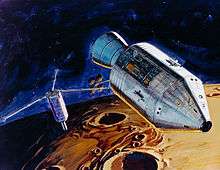
The Apollo 15 subsatellite (PFS-1) was a small satellite released into lunar orbit from the SIM bay. Its main objectives were to study the plasma, particle, and magnetic field environment of the Moon and map the lunar gravity field. Specifically, it measured plasma and energetic particle intensities and vector magnetic fields, and facilitated tracking of the satellite velocity to high precision. A basic requirement was that the satellite acquire fields and particle data everywhere on the orbit around the Moon.[54] The Moon's roughly circular orbit about the Earth at ~380,000 km (60 Earth radii) carried the subsatellite into both interplanetary space and various regions of the Earth's magnetosphere. The satellite orbited the Moon and returned data from August 4, 1971 until January 1973.
In later years, through a study of many lunar orbiting satellites, scientists came to discover that most low lunar orbits (LLO) are unstable. Fortunately, PFS-1 had been placed, unknown to mission planners at the time, very near to one of only four lunar frozen orbits, where a lunar satellite may remain indefinitely.[56]
Releasing the subsatellite was the crew's final activity in lunar orbit, occurring an hour before the burn to take them back to Earth. A virtually identical subsatellite was deployed by Apollo 16.
Launch vehicle
The Saturn V that launched Apollo 15 was designated SA-510, the tenth flight-ready model of the rocket. As the payload of the rocket was greater, changes were made to its launch trajectory and Saturn V itself. The rocket was launched in a more southerly direction (80–100 degrees azimuth) and the Earth parking orbit lowered to 166 kilometers (90 nautical miles) above the Earth's surface. These two changes meant 1,100 pounds (500 kg) more could be launched. The propellant reserves were reduced and the number of retrorockets on the S-IC first stage (used to separate the spent first stage from the S-II second stage) reduced from eight to four. The four outboard engines of the S-IC would be burned longer and the center engine would also burn longer before being shut down (see Saturn V for more information on the launch sequence). Changes were also made to the S-II to stop pogo oscillations.[54]
Once all the various components had been installed on the Saturn V, it was moved to the launch site, Launch Complex 39A. During late June and early July 1971, the rocket and Launch Umbilical Tower (LUT) were struck by lightning at least four times. All was well however, with only minor damage suffered.
Space suits
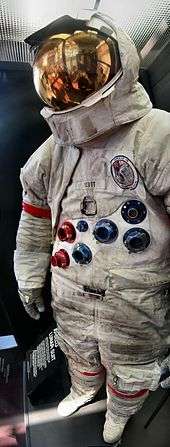
The astronauts themselves wore new space suits. On all previous Apollo flights, including the non-lunar flights, the commander and lunar module pilot had worn suits with the life support, liquid cooling, and communications connections in two parallel rows of three. On Apollo 15, the new suits, dubbed the "A7LB," had the connectors situated in triangular pairs. This new arrangement, along with the relocation of the entry zipper (which went in an up-down motion on the old suits), from the right shoulder to the left hip, allowed the inclusion of a new waist joint, allowing the astronauts to bend completely over and to sit on the rover. Upgraded backpacks allowed for longer-duration moonwalks, and the Command Module Pilot, who wore a suit with three connectors, would wear a five-connector version of the old Moon suit — the liquid cooling water connector being removed, as the Command Module Pilot would make a "deep-space EVA" to retrieve film cartridges on the flight home.[54]
Scandals
After a successful mission, the reputations of the crew and NASA were tarnished by a deal the crew had made with a German stamp dealer.[57] H. Walter Eiermann, who had many professional and social contacts with NASA employees and the astronaut corps, arranged for Scott to carry unauthorized commemorative postal covers in his space suit, in addition to the postal covers NASA had contracted to carry for the United States Postal Service. Eiermann had promised each astronaut $7,000 in the form of savings accounts in return for 100 covers signed after having been on the Moon. He told the astronauts that he would not advertise or sell the covers until the end of the Apollo program. Irwin wrote in his book To Rule the Night that the astronauts had agreed to the deal as a way to help finance their children's college tuition.[58]
Another controversy arose after the flight, caused by the Fallen Astronaut statuette that Scott had left on the Moon. The crew claim they had agreed with the sculptor, Paul Van Hoeydonck, that no replicas were to be made, in order to satisfy NASA's aversion to commercial exploitation of the space program. After the sculpture's existence was publicly disclosed during their post-flight press conference, the National Air and Space Museum contacted the crew asking for a replica made for the museum. Van Hoeydonck, whose account of the agreement contradicts Scott's, subsequently advertised replicas for sale to the public.[59] Under pressure from NASA, Van Hoeydonck withdrew the sale offer. [60]
Mission insignia
.jpg)
The three astronauts of Apollo 15 were all United States Air Force active duty officers, and their patch carries Air Force motifs (just as the Apollo 12 all-Navy crew's patch had featured a sailing ship). The circular patch features stylized red, white and blue birds flying over the Hadley Rille section of the Moon. Immediately behind the birds, a line of craters form the Roman numeral XV. The artwork is circled in red, with a white band giving the mission and crew names and a blue border. Scott contacted fashion designer Emilio Pucci to design the patch, who came up with the basic idea of the three-bird motif on a square patch. The crew changed the shape to round and the colors from blues and greens to a patriotic red, white and blue. Worden stated that each bird also represented an astronaut, white being his own color (and as Command Module Pilot, uppermost), with Scott the blue bird and Irwin the red. The Roman numeral design was created when NASA insisted that the mission number be displayed in Arabic numerals.[61]
Visibility from space
The halo area of the Apollo 15 landing site, generated by the LM's exhaust plume, was observed by a camera aboard the Japanese lunar orbiter SELENE and confirmed by comparative analysis of photographs in May 2008. This corresponds well to photographs taken from the Apollo 15 Command Module showing a change in surface reflectivity due to the plume, and was the first visible trace of manned landings on the Moon seen from space since the close of the Apollo program.[62]
Multimedia
- Apollo 15
 An experiment at LBNL involving high energy particles from a cyclotron used to investigate the origin of the flashes of light seen by Apollo astronauts on their way to the Moon. Experiments were conducted on board Apollos 15, 16 and 17 and Skylab to investigate this phenomenon; with the "Light Flashes Experiment Package" (a box of instrumentation worn on the head during light flash count sequences) flying on Apollos 16 and 17
An experiment at LBNL involving high energy particles from a cyclotron used to investigate the origin of the flashes of light seen by Apollo astronauts on their way to the Moon. Experiments were conducted on board Apollos 15, 16 and 17 and Skylab to investigate this phenomenon; with the "Light Flashes Experiment Package" (a box of instrumentation worn on the head during light flash count sequences) flying on Apollos 16 and 17
Depiction in popular culture
- The Apollo 15 mission is dramatized in the episode "Galileo was Right", of the 1998 HBO miniseries From the Earth to the Moon.
- The lunar rover from Apollo 15 is featured in the PlayStation 3 sim racing game Gran Turismo 6.
- In the classic Avengers story arc, "The Kree-Skrull War" (issues #89-97), published by Marvel Comics in 1971-1972, Captain Marvel attempts to steal the Apollo 15 Saturn V, modify it, and return to the Kree home world to stop Ronan the Accuser.
See also
Notes
- ↑ Mattingly was replaced before launch by Jack Swigert.
- ↑ The Plain was a shoutout to Scott's alma mater, West Point, as that is the name of the parade ground there.[ALSJ 2]
References
![]()
- ↑ Orloff, Richard W. (September 2004) [First published 2000]. "Table of Contents". Apollo by the Numbers: A Statistical Reference. NASA History Division, Office of Policy and Plans. NASA History Series. Washington, D.C.: NASA. ISBN 0-16-050631-X. LCCN 00061677. NASA SP-2000-4029. Archived from the original on August 23, 2007. Retrieved July 18, 2009.
- 1 2 3 4 Orloff & Harland, p. 426.
- ↑ "NASA NSSDC Master Catalog - Apollo 15 LM descent stage". Retrieved 2011-01-01.
- ↑ "1971 Year in Review: Apollo 14 and 15". UPI.com. United Press International. 1971. Retrieved July 19, 2013.
- ↑ Chaikin, pp. 232–233.
- ↑ "Apollo 18 through 20 - The Cancelled Missions". NASA. Retrieved September 4, 2018.
- 1 2 3 4 5 6 "Apollo 15 Crew". Smithsonian Air and Space Museum. Retrieved December 29, 2017.
- ↑ Jones, Eric M., ed. (1996). "Apollo 15 crew information". Apollo 15 Lunar Surface Journal. NASA. Retrieved September 4, 2018.
- ↑ Worden, 2433.
- 1 2 3 4 5 6 7 8 9 Richard W. Orloff (ed.). "Capsule Communicators (Capcoms)". Apollo by the Numbers. Retrieved September 8, 2018.
- 1 2 3 4 5 6 Orloff & Harland, p. 430.
- ↑ Orloff & Harland, pp. 279, 327, 393–394, 426.
- ↑ Chaikin, pp. 387–396.
- ↑ Chaikin, pp. 397–402.
- ↑ Reynolds, p. 171.
- ↑ Lindsay, p. 303.
- ↑ Scott & Leonov, 4490–4513.
- ↑ Compton, p. 236.
- ↑ Chaikin, pp. 402–403.
- ↑ Scott & Leonov, 4521–4529.
- ↑ Reynolds, p. 172.
- ↑ Harland, p. 80.
- ↑ Scott & Leonov, 4412.
- ↑ Worden, 2373–2408.
- ↑ Scott & Leonov, 4571–4579.
- ↑ Mission Report, p. 1.
- 1 2 Orloff & Harland, p. 431.
- 1 2 Orloff & Harland, p. 435.
- 1 2 3 Orloff & Harland, p. 432.
- ↑ Reynolds, p. 174.
- ↑ Irwin, p. 59.
- ↑ Chaikin, pp. 414–415.
- ↑ Scott & Leonov, 4865–4869.
- ↑ Beattie, p. 231.
- ↑ Irwin, p. 61.
- ↑ Chaikin, p. 415.
- ↑ Harland, pp. 89–90, 358–359.
- ↑ Harland, pp. 90–93.
- ↑ Harland, pp. 93–94.
- ↑ Harland, pp. 96–97.
- ↑ Chiakin, pp. 418–419.
- ↑ Harland, pp. 106–107.
- ↑ Harland, pp. 107–114, 315.
- ↑ Harland, p. 115.
- 1 2 3 4 Wade, Mark. "Apollo 15". Encyclopedia Astronautica. Archived from the original on August 5, 2011. Retrieved July 14, 2011.
- ↑ Unknown at the time, two of the original selection of 20 cosmonauts had also died before Apollo 15: Valentin Bondarenko in a fire during training in March 1961 and Grigori Nelyubov in a train accident/suicide in February 1966.
- ↑ Apollo Lunar Surface Journal
- ↑ "Q&A with Apollo 15 astronaut Dave Scott". 2015. Retrieved July 26, 2018.
- 1 2 Woods, W. David; O'Brien, Frank. "Apollo 15 Flight Journal". Apollo 15 Flight Journal. NASA. Archived from the original on July 20, 2011. Retrieved July 14, 2011.
- ↑ Woods, W. David; O'Brien, Frank. "Day 11: Worden's EVA Day". Apollo 15 Flight Journal. NASA. Archived from the original on June 29, 2011. Retrieved July 14, 2011.
- ↑ Lindsay, pp. 301–302.
- ↑ "Location of Apollo Lunar Modules". Smithsonian Air and Space Museum. Retrieved September 9, 2018.
- ↑ Jones, Eric M., ed. (1995). "Mission Summary: Mountains of the Moon". Apollo 15 Lunar Surface Journal. NASA. Retrieved September 4, 2018.
- 1 2 3 4 "Apollo 15 Press Kit" (PDF). Washington, D.C.: NASA. July 15, 1971. Release No: 71-119K. Archived from the original (PDF) on March 27, 2009. Retrieved July 14, 2011.
- ↑ Compton, p. 230.
- ↑ Bell, Trudy E. (November 6, 2006). Phillips, Tony, ed. "Bizarre Lunar Orbits". Science@NASA. NASA. Retrieved December 9, 2012.
Lunar mascons make most low lunar orbits unstable ... As a satellite passes 50 or 60 miles overhead, the mascons pull it forward, back, left, right, or down, the exact direction and magnitude of the tugging depends on the satellite's trajectory. Absent any periodic boosts from onboard rockets to correct the orbit, most satellites released into low lunar orbits (under about 60 miles or 100 km) will eventually crash into the Moon. ... [There are] a number of 'frozen orbits' where a spacecraft can stay in a low lunar orbit indefinitely. They occur at four inclinations: 27°, 50°, 76°, and 86°"—the last one being nearly over the lunar poles. The orbit of the relatively long-lived Apollo 15 subsatellite PFS-1 had an inclination of 28°, which turned out to be close to the inclination of one of the frozen orbits—but poor PFS-2 was cursed with an inclination of only 11°.
- ↑ Patterson, Thom (July 27, 2011). "Apollo's most controversial mission". Light Years (Blog). CNN. Retrieved July 27, 2011.
- ↑ Irwin & Emerson 1973
- ↑ Powell, Corey S.; Shapiro, Lauren G. (2013). "The Sculpture on the Moon". Slate. The Slate Group.
- ↑ Van den Bussche 1980, pp. 16–17
- ↑ Worden & French 2011, pp. 144–145
- ↑ "The 'halo' area around Apollo 15 landing site observed by Terrain Camera on SELENE(KAGUYA)" (Press release). Chōfu, Tokyo: Japan Aerospace Exploration Agency. May 20, 2008. Retrieved July 19, 2013.
Apollo Lunar Flight Journal
- 1 2 Woods, W. David; O'Brien, Frank, eds. (1998). "Launch and Reaching Earth Orbit". Apollo 15 Flight Journal. NASA. Retrieved September 5, 2018.
- ↑ Woods, W. David; O'Brien, Frank, eds. (1998). "Earth Orbit and Translunar Injection". Apollo 15 Flight Journal. NASA. Retrieved September 5, 2018.
- ↑ Woods, W. David; O'Brien, Frank, eds. (1998). "Transposition, Docking and Extraction". Apollo 15 Flight Journal. NASA. Retrieved September 5, 2018.
- ↑ Woods, W. David; O'Brien, Frank, eds. (1998). "Day 2: Checking the SPS". Apollo 15 Flight Journal. NASA. Retrieved September 5, 2018.
- 1 2 Woods, W. David; O'Brien, Frank, eds. (1998). "Day 2: Entering the LM". Apollo 15 Flight Journal. NASA. Retrieved September 5, 2018.
- ↑ Woods, W. David; O'Brien, Frank, eds. (1998). "Day 3: Leaking Water and the Top of the Hill". Apollo 15 Flight Journal. NASA. Retrieved September 5, 2018.
- ↑ Woods, W. David; O'Brien, Frank, eds. (1998). "Day 4: Lunar Encounter". Apollo 15 Flight Journal. NASA. Retrieved September 5, 2018.
- ↑ Woods, W. David; O'Brien, Frank, eds. (1998). "Day 4: Lunar Orbit". Apollo 15 Flight Journal. NASA. Retrieved September 5, 2018.
- ↑ Woods, W. David; O'Brien, Frank, eds. (1998). "Day 5: Waking in the Descent Orbit". Apollo 15 Flight Journal. NASA. Retrieved September 6, 2018.
- ↑ Woods, W. David; O'Brien, Frank, eds. (1998). "Day 5: Preparations for Landing". Apollo 15 Flight Journal. NASA. Retrieved September 6, 2018.
Apollo Lunar Surface Journal
- ↑ Jones, Eric M., ed. (1995). "Sampling at Head Crater and Bench Crater". Apollo 12 Lunar Surface Journal. NASA. Retrieved September 4, 2018.
- 1 2 3 4 5 6 Jones, Eric M., ed. (1996). "Landing at Hadley". Apollo 15 Lunar Surface Journal. NASA. Retrieved July 14, 2011.
- ↑ Jones, Eric M., ed. (1996). "Deploying the Lunar Roving Vehicle". Apollo 15 Lunar Surface Journal. NASA. Retrieved September 13, 2018.
- ↑ Jones, Eric M., ed. (1996). "Stand-Up EVA". Apollo 15 Lunar Surface Journal. NASA. Retrieved July 14, 2011.
- ↑ Jones, Eric M., ed. (1996). "Wake-up for EVA-1". Apollo 15 Lunar Surface Journal. NASA. Retrieved September 9, 2018.
- ↑ Jones, Eric M., ed. (1996). "Preparations for EVA-1". Apollo 15 Lunar Surface Journal. NASA. Retrieved September 13, 2018.
- ↑ Jones, Eric M., ed. (1996). "Driving to Elbow Crater". Apollo 15 Lunar Surface Journal. NASA. Retrieved September 16, 2018.
- 1 2 3 4 Jones, Eric M. (1995). "Mountains of the Moon". Apollo 15 Lunar Surface Journal (Essay). NASA. Retrieved June 28, 2011.
- ↑ Jones, Eric M., ed. (1996). "Stand-Up EVA". Apollo 15 Lunar Surface Journal. NASA. Retrieved September 9, 2018.
Bibliography
- Beattie, Donald A. (2001). Taking Science to the Moon. Baltimore, MD: The Johns Hopkins University Press. ISBN 978-0-8018-7440-6.
- Chaikin, Andrew (1994). A Man on the Moon: The Voyages of the Apollo Astronauts. New York: Viking. ISBN 0-670-81446-6. LCCN 93048680.
- Compton, William D. (1989). Where No Man Has Gone Before: A History of Apollo Lunar Exploration Missions. Washington, D.C.: U.S. Government Printing Office. OCLC 1045558568.
- Harland, David M. Exploring the Moon: The Apollo Expeditions. ISBN 978-1-85233-099-6.
- Irwin, James B.; Emerson, William A., Jr. (1973). To Rule the Night: The Discovery Voyage of Astronaut Jim Irwin (1st ed.). Philadelphia: A. J. Holman Co. ISBN 0-87981-024-6. LCCN 73011410.
- Lattimer, Dick (1985). All We Did Was Fly to the Moon. History-alive series. 1. Foreword by James A. Michener (1st ed.). Alachua, FL: Whispering Eagle Press. ISBN 0-9611228-0-3. LCCN 85222271.
- Lindsay, Hamish (2001). Tracking Apollo to the Moon. London, UK: Springer-Verlag. ISBN 978-1-85233-212-9.
- Apollo 15 Mission Report. Houston, TX: NASA. 1971.
- Orloff, Richard W.; Harland, David M. (2006). Apollo: The Definitive Sourcebook. Chichester, United Kingdon: Praxis Publishing Company. ISBN 978-0-387-30043-6.
- Reynolds, David West (2002). Apollo: The Epic Journey to the Moon, 1963-1972. San Diego, CA: Tehabi Books Ltd. ISBN 978-0-7603-4452-1.
- Scott, David; Leonov, Alexei (2004). Two Sides of the Moon: Our Story of the Cold War Space Race. New York, NY: Thomas Dunne Books. ISBN 978-0-7434-5067-6.
- Van den Bussche, Willy (1980). Paul van Hoeydonck. Tielt: Lannoo. ISBN 90-209-0885-5.
- Worden, Al; French, Francis (2011). Falling to Earth: An Apollo 15 Astronaut's Journey. Washington, D.C.: Smithsonian Books. ISBN 978-1-58834-309-3. LCCN 2011003440.
External links
| This article is part of a series on |
| Apollo 15 |
|---|
| Wikimedia Commons has media related to Apollo 15. |
- "To see Earth and Moon in a single glance: An interview with Apollo 15 Astronaut Al Worden, on the 45th anniversary of his epic voyage to the Moon"
- "Apollo 15" at Encyclopedia Astronautica
- "Apollo 15 Command and Service Module (CSM)" at the National Space Science Data Center, NASA
- ""Apollo 15 Sieger Flown Moon Covers"". Archived from the original on March 1, 2001. Retrieved 2005-06-18.
NASA reports
- Apollo 15 Press Kit (PDF), NASA, Release No. 71-119K, July 15, 1971
- Apollo 15 Preliminary Science Report (PDF), NASA, Manned Spacecraft Center. NASA SP-289, 1972
- "Apollo Program Summary Report" (PDF), NASA, JSC-09423, April 1975
- Moonport: A History of Apollo Launch Facilities and Operations by Charles D. Benson and William Barnaby Faherty. NASA SP-4204, 1978
- "Articles Carried on Manned Space Flights" NASA News Release 72-189, September 15, 1972. Reprinted at collectSPACE.com
- Apollo 15 Flight Journal
- Apollo 15 Lunar Surface Journal
Multimedia
- Apollo 15: In the Mountains of the Moon (Part 1) | (Part 2) NASA documentary film HQ-217 on the Apollo 15 mission at the Internet Archive
- "Episode 45: 4th July 2011: Apollo 15 Command Module Pilot Al Worden" Interview with AstrotalkUK (Podcast), recorded in London on May 22, 2011
- "Apollo 15 Launch - Video" at Maniac World
- Apollo launch and mission videos at ApolloTV.net

